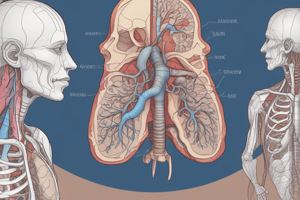Podcast
Questions and Answers
What is the primary function of the lungs?
What is the primary function of the lungs?
- To digest food
- To produce energy
- To exchange oxygen and carbon dioxide (correct)
- To filter blood
Where does the exchange of gases occur within the lungs?
Where does the exchange of gases occur within the lungs?
- In the alveoli (correct)
- In the trachea
- In the pleura
- In the bronchi
What does pleurisy affect?
What does pleurisy affect?
- The alveoli
- The trachea
- The bronchi
- The pleura (correct)
What is a common sign of asthma?
What is a common sign of asthma?
What can lead to the development of asthma?
What can lead to the development of asthma?
What type of drugs are typically used to treat most cases of asthma?
What type of drugs are typically used to treat most cases of asthma?
Flashcards are hidden until you start studying
Study Notes
The Lungs
- The lungs are spongy organs responsible for exchanging oxygen and carbon dioxide through tiny air sacs called alveoli.
- Oxygen and carbon dioxide are exchanged in and out of capillaries in the alveoli.
- The breathing passages (nose, throat, trachea, and bronchi) are lined with mucous membranes that provide an initial defense against pathogens and irritants.
- The lungs are highly vulnerable to disease and can become seriously diseased.
Inflammatory Diseases
- Pleurisy is a disease caused by inflammation of the pleura, the double membranes surrounding each lung and lining the chest cavity.
- Pleurisy can occur as a complication of pneumonia or result from direct infection of the pleura.
- Asthma is a disease caused by inflammation of the muscle surrounding the airways.
- Asthma is characterized by wheezing or whistling sounds accompanying each breath.
- Asthma can arise from chronic bronchitis, respiratory allergies, or exposure to airborne irritants over long periods.
- Most cases of asthma are treated with inhalable drugs that reduce inflammation and relax the bronchiolar muscle.
- Serious cases of asthma may require oral corticosteroids.
Studying That Suits You
Use AI to generate personalized quizzes and flashcards to suit your learning preferences.




